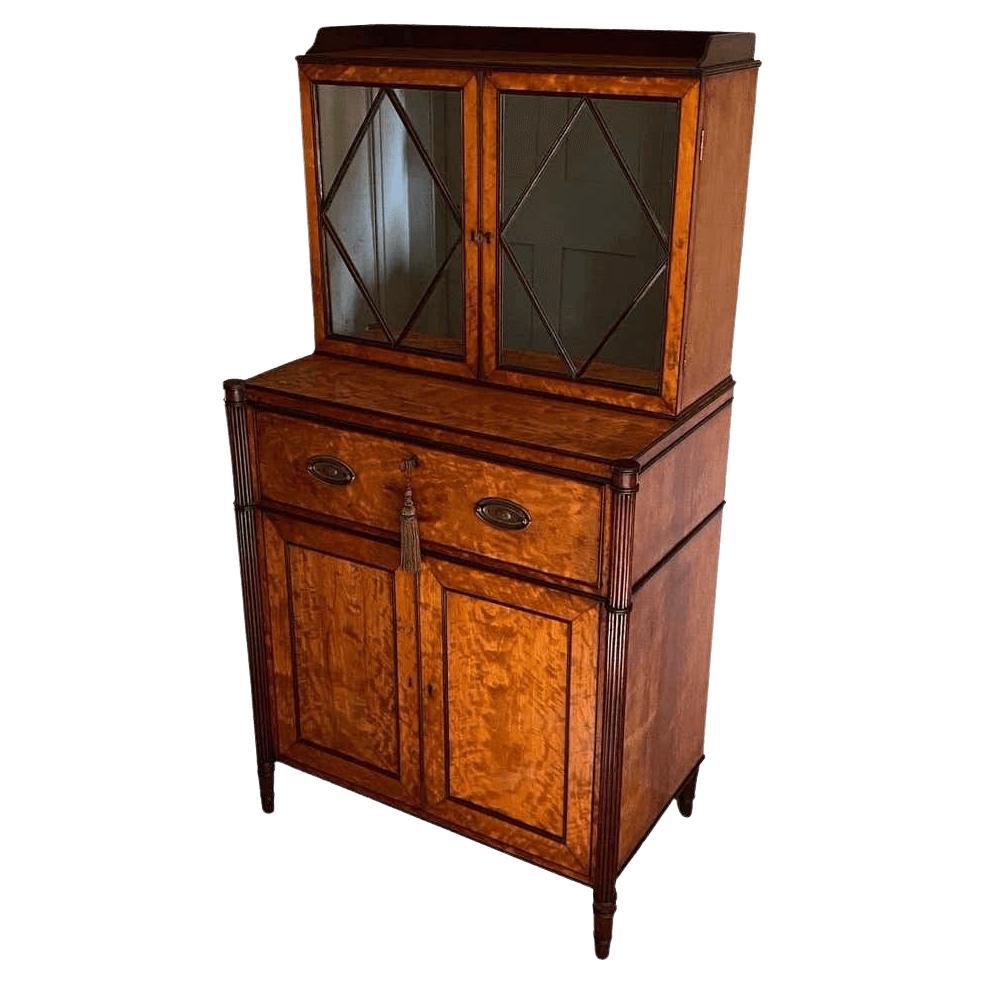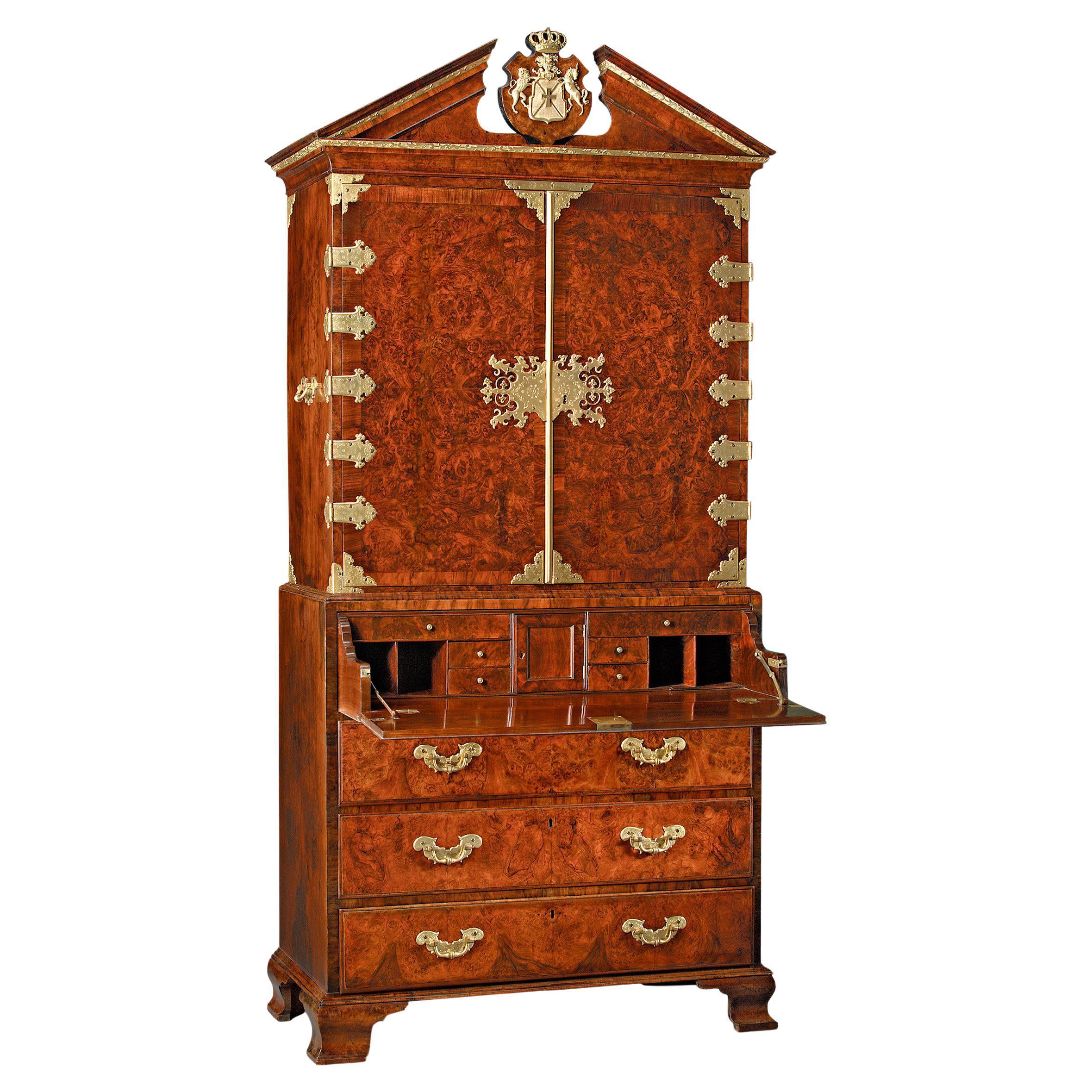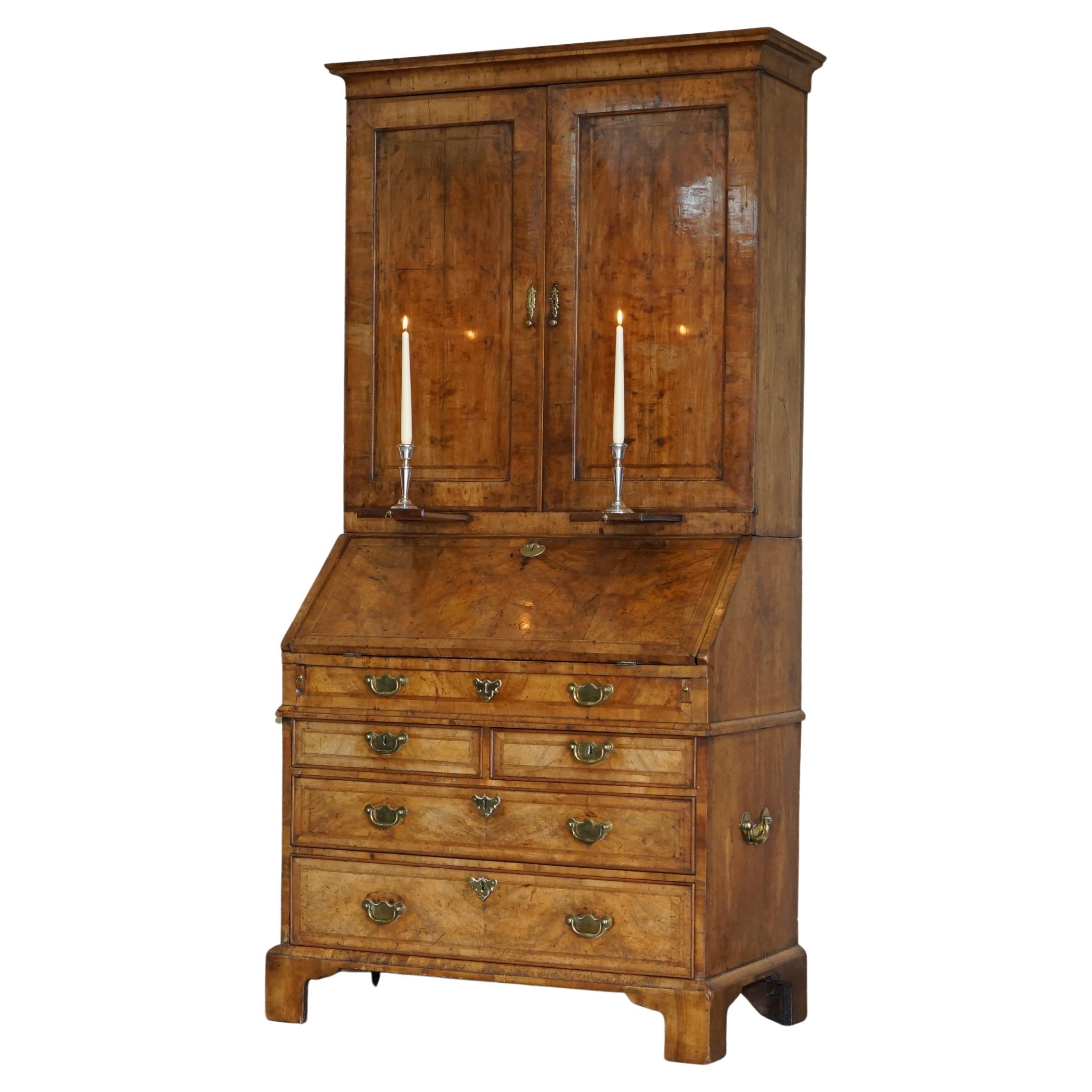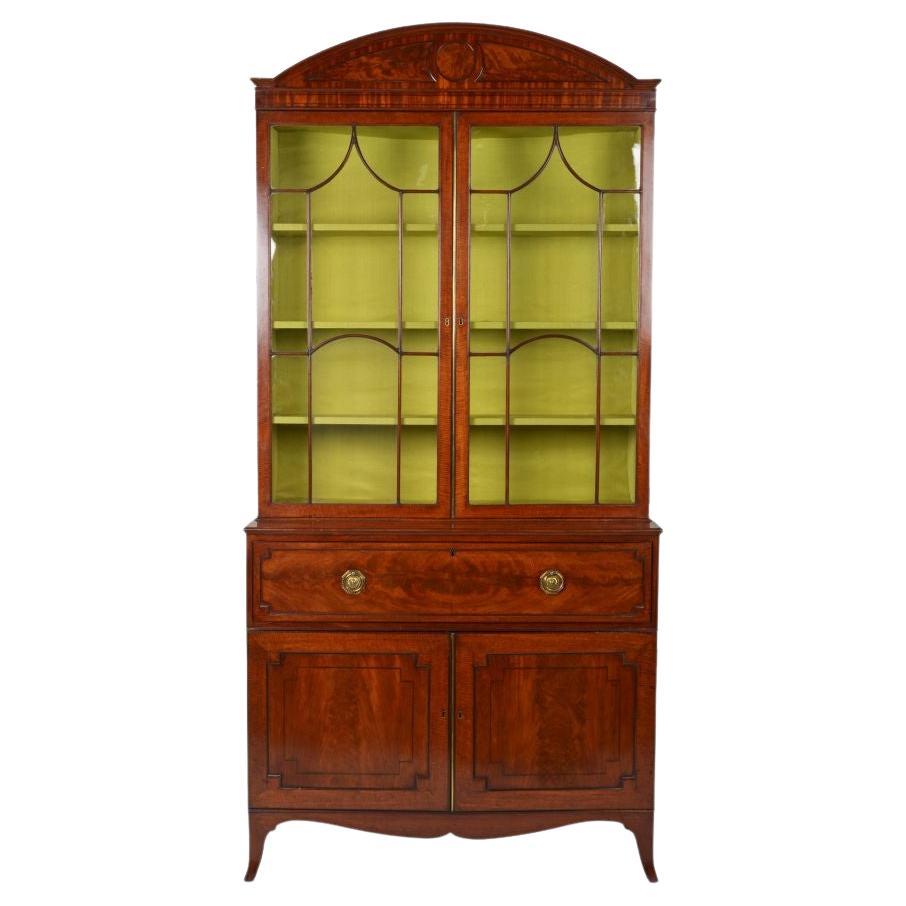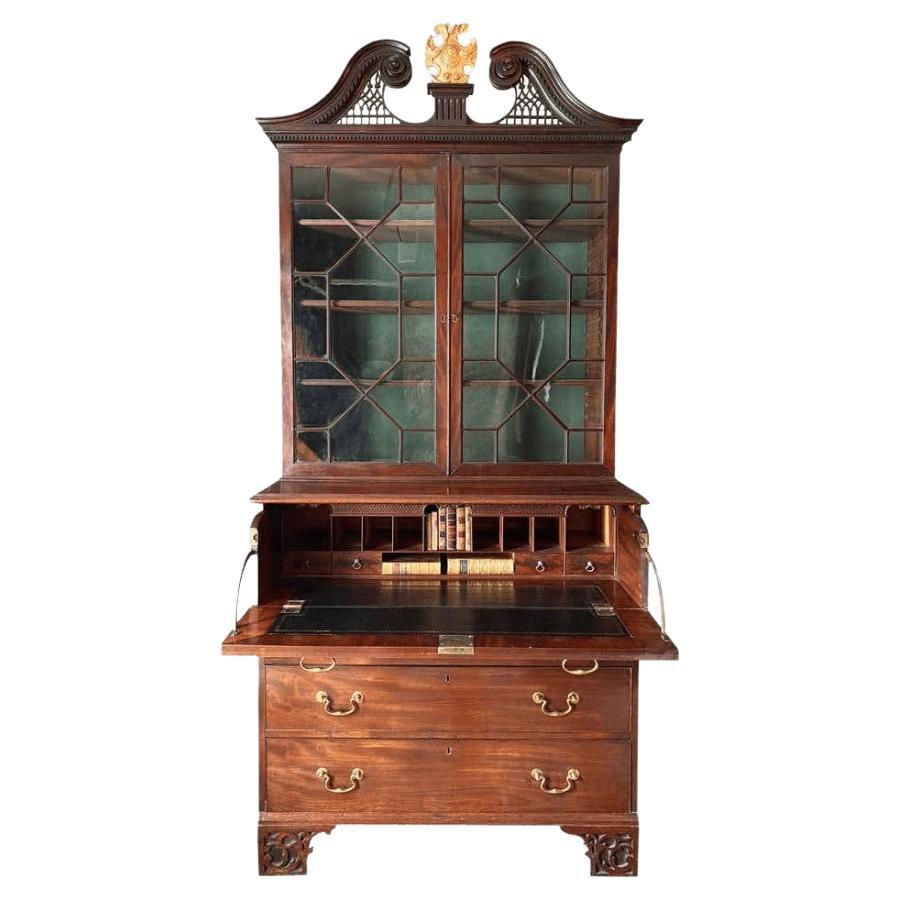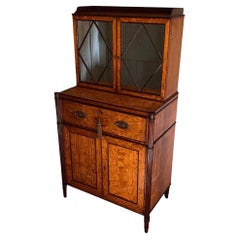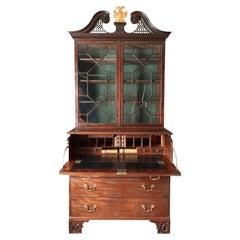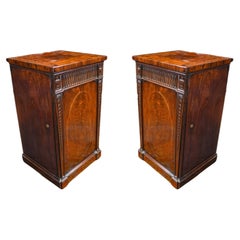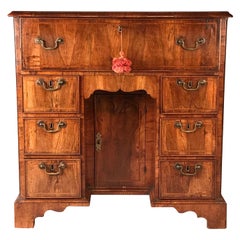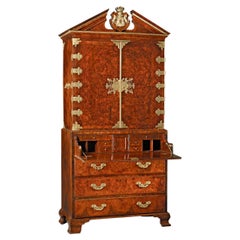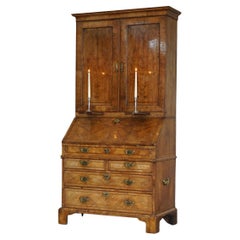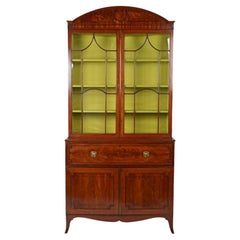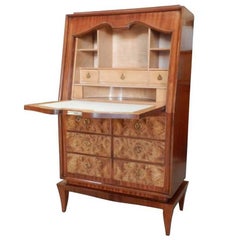Items Similar to A Fine Old & Ody George I Burr Walnut Secretaire Cabinet
Video Loading
Want more images or videos?
Request additional images or videos from the seller
1 of 18
A Fine Old & Ody George I Burr Walnut Secretaire Cabinet
About the Item
A fine English George I-period burr (burl) walnut secretaire cabinet attributed to Old & Ody.
Early-18th century, ca 1720.
The top section separates from the base and opens to reveal numerous fitted drawers, behind doors with original bevelled arched mirror plates.
The base contains a fall-front fitted secretaire with small drawers, two of which have secret drawers. Engraved mounts are contemporary if not original. All locks and cross-grained mouldings are original.
Beautiful deep rich colour throughout, with superb matched burr veneers within herringbone lines.
Bun feet are original. Lined throughout in best-quality English oak.
The well patinated, green, gilt-tooled liner in the writing surface appears original. In excellent condition overall.
Very much in the style of John Old & William Ody.
One of the most original early-18th century pieces of English walnut cabinet furniture we have been able to offer during the last 67 years.
Provenance: David Tron, 275 King's Road, London, SW3.
Literature:
C. Gilbert, 'A Pictorial Dictionary of Marked London Furniture 1700-1840' (1986) fig. 600.
Further reading:
Old, William & Ody, John (1717-1733) The Furniture History Society - British and Irish Furniture Makers Online.
References:
National Trust Collections:
William Old & John Ody, St. Pauls Church Yard, London (c.1723-38) - vis a cabinet on chest, Montacute House, Somerset, England.
- Dimensions:Height: 75 in (190.5 cm)Width: 43 in (109.22 cm)Depth: 22 in (55.88 cm)
- Style:George I (Of the Period)
- Materials and Techniques:
- Place of Origin:
- Period:
- Date of Manufacture:circa 1720
- Condition:Replacements made: Historical re-attachment of old veneers. Very skilfully executed. Wear consistent with age and use. Engraved mounts are contemporary if not original. All locks and cross-grained mouldings are original. Beautiful colour displayed throughout with superb matched burr veneers within herringbone lines. Bun feet are original.
- Seller Location:Lymington, GB
- Reference Number:Seller: BHA 12091stDibs: LU4081124677732
About the Seller
5.0
Vetted Professional Seller
Every seller passes strict standards for authenticity and reliability
Established in 1957
1stDibs seller since 2018
36 sales on 1stDibs
- ShippingRetrieving quote...Shipping from: Lymington, United Kingdom
- Return Policy
Authenticity Guarantee
In the unlikely event there’s an issue with an item’s authenticity, contact us within 1 year for a full refund. DetailsMoney-Back Guarantee
If your item is not as described, is damaged in transit, or does not arrive, contact us within 7 days for a full refund. Details24-Hour Cancellation
You have a 24-hour grace period in which to reconsider your purchase, with no questions asked.Vetted Professional Sellers
Our world-class sellers must adhere to strict standards for service and quality, maintaining the integrity of our listings.Price-Match Guarantee
If you find that a seller listed the same item for a lower price elsewhere, we’ll match it.Trusted Global Delivery
Our best-in-class carrier network provides specialized shipping options worldwide, including custom delivery.More From This Seller
View AllFine Gillows George III Period Satinwood Secretaire Cabinet
Located in Lymington, GB
An exceptional English Sheraton-period satinwood secretaire cabinet. Attributed to Gillows.
Late-18th century, George III, ca 1790.
Measures:
H 59 1/2’’ (151 cm)
W 30’’ (76 cm)
D 19’’ (49 cm).
This small, beautifully-proportioned, and sophisticated antique writing cabinet...
Category
Antique Late 18th Century English George III Secretaires
Materials
Satinwood
18th Century Mahogany Secretaire Bookcase China Cabinet
Located in Lymington, GB
A fine English mid-18th century mahogany secretaire / secretary / bookcase / china cabinet.
Of lovely, deep, rich color, patina and quality.
George III-period, circa 1760.
The bold, detachable, swan-neck pediment carved with 'Gothic' open fretwork, spiral rosettes and a dentil cornice.
The pediment is centred by a small platform below which is a fluted panel. The bookcase / china cabinet section with two, thirteen-pane glazed doors, with three original adjustable shelves with applied beadings for the display of china etc.
The base with a pull-out writing section fitted with small drawers, two of which have secret releases. These secret drawers are faced with blind-fret 'Gothic' tracery, and centred by a carved, shaped arch.
The base with three cock-beaded drawers, and raised on its original bracket feet which are faced with blind fret.
This fine, sophisticated and well-proportioned example of a secretaire / secretary / cabinet / desk / bookcase is remarkable for having survived in its original state including all swan-neck handles and locks.
Of superb quality, color, patination, and well figured throughout. With mahogany drawer linings: further confirmation of its superlative quality.
Measures:
42" wide (107 cm)
23" deep 58.5 cm)
95" high (241 cm) - without cartouche.
A related antique bureau cabinet...
Category
Antique 1740s English George III Cabinets
Materials
Mahogany
Fine Pair George III Gillows Pedestal Cabinets
Located in Lymington, GB
A fine pair of English George lll-period pedestal cabinets in well-figured mahogany of deep, rich colour and superb patination, attributed to Gillows of Lancaster, circa 1800.
The f...
Category
Antique 19th Century English George III Cabinets
Materials
Mahogany
George I Walnut Secretaire Kneehole Desk
Located in Lymington, GB
An early-18th century English walnut secrétaire kneehole desk.
George I-period (1714-1727), circa 1720.
Of exceptional waxed honey colour and lovely old patina, with well-matched veneers.
With a quarter-veneered top. Six short drawers below a hinged fall revealing a writing section, all surrounding a central recessed cupboard. There is a small, shaped pull-out drawer fitted in the apron.
All finely inlaid with herringbone lines. Raised on its original bracket feet. Swan-neck handles probably fitted later in the 18th century. Locks and keys are mostly original. Walnut veneered and crossbanded sides.
Nb. Having a fitted secrétaire (secretaire) drawer distinguishes this antique walnut kneehole desk...
Category
Antique Early 18th Century English George I Desks
Materials
Walnut
George II Mahogany Bureau Cabinet Bookcase
Located in Lymington, GB
An elegant 18th-century mahogany bureau cabinet of impressive architectural form, and lovely rich colour.
George II-period, circa 1740.
The top surmounted by a bold architectural pediment and centred by a brass finial. The two arched panel doors reveal three adjustable shelves which have candle slides below them. Furthermore the bureau section is fitted with a stepped interior. This has two secret compartments, drawers and pigeon holes, and the fall is conventionally supported on two lopers. Lined in the best quality English oak.
The blind doors of this Georgian cabinet have well figured mahogany panels of very good colour which reflect beautifully in the candle light.
The chamfered and arched doors display a further level of sophistication and quality. The beautifully drawn arched pediment is in perfect proportion with the rest of the cabinet/ bookcase.
In excellent condition overall.
Architectural furniture designs on the continent commenced with the arrival of the Renaissance, and they have their origins in Roman and Greek architecture.
Nb. We often refer to antique bookcases / cabinets as ''secretary desks'' in the US.
Bureau bookcases display books, china or silver behind glazed doors, but are described more accurately as bureau cabinets when they are fitted with blind doors.
Further reading, re pediments, etc:
'Illustrated Dictionary...
Category
Antique 1740s English George II Cabinets
Materials
Glass, Mahogany
George II Mahogany Bureau Cabinet Bookcase
Located in Lymington, GB
A very impressive mahogany bureau cabinet / bookcase / secretary*, with secret compartments. In the manner of Giles Grendey (1693-1780).
In mahogany and parcel gilt.
Mid-18th century, George II period.
This English bureau cabinet displays fine, deep, rich colour and superb surface patination throughout.
The top section with a broken-arch pediment and dentil cornice. The frieze well carved with Gothic arcaded blind fretwork. Centred by a later urn-shaped finial.
The cabinet with two carved parcel-gilt gesso bordered ogee shaped doors. Old but apparently later mirror plates enclosing a fitted interior with eight drawers and adjustable shelves.
The cleated fall, with its original lock, now fitted with a wine red, gilt-tooled writing surface revealing an exceptionally high-quality arrangement of canopied drawers and pigeon holes. The interior is centred by an arched, architectural over door...
Category
Antique 18th Century English George II Bookcases
Materials
Mahogany
You May Also Like
King George I Ambassadorial Secrétaire-Cabinet
Located in New Orleans, LA
This highly important secrétaire-cabinet was crafted for and specially ordered by King George I for the British Ambassador to Russia. From its craftsmanship and materials to its exceptional artistry, it is a work of royal and historic significance that exudes power in each and every detail. The broken pediment at its apex features the simplified royal coat of arms bearing the king’s crown, while the interior is adorned by portraits of the British Royal Family. Placed within the ambassador’s St. Petersburg home, this entirely unique piece of furniture would have been a potent reminder of England's grandeur and political importance.
Relations between England and Russia during this period were at an all-time high. Peter the Great had traveled to England in 1698 as part of his widely known “Grand Embassy” tour, wherein he attempted to gain foreign support against the Ottoman Empire. He spent a period of nearly four months there, meeting with King William III and his court on numerous occasions. Noted academic Arthur MacGregor wrote concerning the impact of the trip, “For two decades following Peter's visit, British influence in Russia reached a peak. It manifested itself in social custom, in craft practice and in ships and naval organization... it reached a significant sector of the population before relations cooled once again and the two nations pulled back from this era of unprecedented cordiality.”
First and foremost, however, it is a reminder of British might and influence. By the reign of King George I, England had come into its own as a world power. Unique in its design, this cabinet is a reflection of the country’s might. It is crafted from the highest-quality solid walnut and burr walnut adorned by gilded lock plates and engraved hinges. The presence of ormolu at its apex and lining the doors was a rarity for this period, and its addition makes manifest the importance of the design.
The outer doors open to reveal multiple interiors, including fifteen separate drawers around a central cupboard; the cupboard doors each bear mezzotint portraits of George I and his father, Ernest Augustus, Elector of Hanover. An etching after the portrait of George I dating to circa 1716 is in London’s Royal Academy. A second, inner pair of doors are adorned by mezzotints of the Prince and Princess of Wales (later Queen Caroline and George II), which are both after portraits by Sir Godfrey Kneller dated 1716 in the Royal Collection. A final portrait is revealed on the very interior of the cabinet, where a mezzotint of Frederick, Anne, Amelia and Caroline, children of the Prince of Wales, resides. An etching (circa 1715-1720) after this portrait can be found in the National Portrait Gallery (London).
Apart from its abundance of royal portraiture, the cabinet features stunning painted decoration, including floral designs as well as clouds, birds and trees in a bucolic motif reminiscent of Eden. Its lower portion is a study in both form and function, featuring a fitted secrétaire-drawer above three additional drawers for storage. The cabinet appears in The Shorter Dictionary of English Furniture by R. Edwards from 1964, a text that is regarded as the bible of British furniture design. Edwards describes it as a “writing cabinet...given by George I to the British Ambassador at the Russian court.”
The cabinet was likely made for the 18th-century German diplomat and writer Friedrich Christian Weber, who represented English interests at the Russian court from 1714 until 1719. Although Weber’s tenure as ambassador was relatively short, while in St. Petersburg, he authored his account entitled Das veraenderte Russland (The Present State of Russia), which was published in three volumes in 1721, 1739 and 1740. It may, however, also have been made for George Douglas, 2nd Earl of Dumbarton, who served as ambassador alongside Weber in 1716. Diplomatic relations ceased between the two countries in 1721.
In 1928, the cabinet appeared for sale at the International Exhibition of Antiques & Works of Art in Olympia. It had previously been in the collection of the Woltner family of Bordeaux, the celebrated vintners who owned the estate Château Laville Haut-Brion and produced wine of the same name. According to the family, Monsieur Woltner was given the cabinet as a gift from an aunt who lived in Russia for many years. After leaving the Woltner collection, the cabinet was acquired by William Berry...
Category
Antique 18th Century English Georgian Secretaires
Materials
Brass
Fine Antique George II Circa 1740 Burr Walnut Bureau Bookcase Chest of Drawers
Located in West Sussex, Pulborough
We are delighted to offer for sale this very fine Burr Walnut & Brass George II circa 1740 Library Bureau Bookcase with campaign handles
A very good looking and well made piece, ...
Category
Antique 1740s English George II Secretaires
Materials
Walnut
Fine George III Flame-Figured Mahogany Secretaire Cabinet
Located in New York, NY
The arched pediment centered by paneled roundel, over two glazed doors with pointed astragals opening to a chartreuse silk-lined interior with shelves; the lower part with a pullout ...
Category
Antique Early 1800s English George III Secretaires
Materials
Brass
Rene Drouet Attributed, Art Deco walnut and Thuya Burr Cabinet
By René Drouet
Located in Saint-Ouen, FR
Rene Drouet attributed, Art Deco walnut and thuya burr cabinet.
Ivory and interior in sycamore veneer.
Secret drawers, original bronzes.
Fully restored. F...
Category
Vintage 1930s French Art Deco Secretaires
Materials
Bronze
Italian Mahogany Secretaire Cabinet, 1950s
Located in Meda, MB
Precious cabinet secretaire produced in Italy in the 1950s,
The whole cabinet is veneered in mahogany with a fine solid wood carving in the center of the two doors representing two b...
Category
Vintage 1950s Italian Mid-Century Modern Cabinets
Materials
Mahogany, Maple
Fine Burr Walnut George I Bureau Bookcase
Located in New York, NY
The broken arched pediment surmounted by classical urn finials over two mirror front doors opening to adjustable shelves over pigeonholes and three short drawers; the lower part with...
Category
Antique 18th Century and Earlier British Secretaires
Materials
Brass
Recently Viewed
View AllMore Ways To Browse
Antique Irish Furniture
Old Antique Kitchens
Small Walnut Cabinet
England Small Cabinet
Used Tool Cabinets
Burr Cabinet
Bun Feet Cabinet
Antique Match Case
English Walnut Cabinets
Old English Antique Plate
Burr Walnut Cabinets
King George Furniture
Fine Small Cross
Secret Cabinet
Antique Tool Cabinets
Cabinet Secret Drawers
Used Kitchen Cabinets London
National Trust
